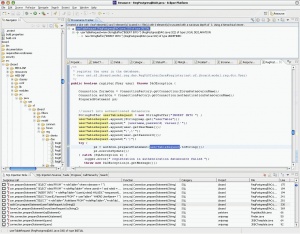This site is the archived OWASP Foundation Wiki and is no longer accepting Account Requests.
To view the new OWASP Foundation website, please visit https://owasp.org
OWASP LAPSE Project
Main
LAPSE: Web Application Security Scanner for Java
News
- 8/23/2006 - version 2.5.5 released (see http://suif.stanford.edu/~livshits/work/lapse/download.html)
- 8/22//2006 - OWASP LAPSE Project Created
Overview
LAPSE stands for a Lightweight Analysis for Program Security in Eclipse. LAPSE is designed to help with the task of auditing Java J2EE applications for common types of security vulnerabilities found in Web applications. LAPSE was developed by Benjamin Livshits as part of the Griffin Software Security Project.
LAPSE targets the following Web application vulnerabilities:
* Parameter manipulation * SQL injections * Header manipulation * Cross-site scripting * Cookie poisoning * HTTP splitting * Command-line parameters * Path traversal
What should you do to avoid these vulnerabilities in your code? How do we protect Web applications from exploits? The proper way to deal with these types of attacks is by sanitizing the tainted input. Please refer to the OWASP guide to find out more about Web application security.
If you are interested in auditing a Java Web application, LAPSE helps you in the following ways:
- Identify taint sources
- Identify taint sinks
- Find paths between sources and sinks
LAPSE is inspired by existing lightweight security auditing tools such as RATS, pscan, and FlawFinder. Unlike those tools, however, LAPSE addresses vulnerabilities in Web applications. LAPSE is not intended as a comprehensive solution for Web application security, but rather as an aid in the code review process. Those looking for more comprehensive tools are encouraged to look at some of the tools produced by Fortify or Ounce Labs.
For now, LAPSE is housed at http://suif.stanford.edu/~livshits/work/lapse/
Contributors
Feedback and Participation:
We hope you find the OWASP LAPSE Project useful. Please contribute to the Project by volunteering for one of the Tasks, sending your comments, questions, and suggestions to [email protected]. To join the OWASP LAPSE Project mailing list or view the archives, please visit the subscription page.
Project About
| PROJECT INFO What does this OWASP project offer you? |
RELEASE(S) INFO What releases are available for this project? | |||||||||||||||||||||||||||||||||||||||||||||
|---|---|---|---|---|---|---|---|---|---|---|---|---|---|---|---|---|---|---|---|---|---|---|---|---|---|---|---|---|---|---|---|---|---|---|---|---|---|---|---|---|---|---|---|---|---|---|
|
| |||||||||||||||||||||||||||||||||||||||||||||
